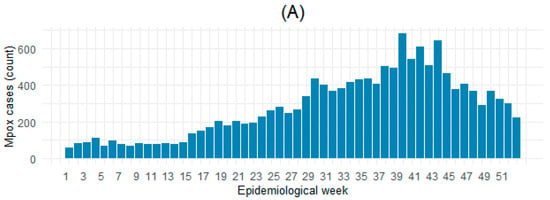Journal Description
Microorganisms
Microorganisms
is a scientific, peer-reviewed, open access journal of microbiology, published monthly online by MDPI. The Hellenic Society Mikrobiokosmos (MBK), the Spanish Society for Nitrogen Fixation (SEFIN) and the Society for Microbial Ecology and Disease (SOMED) are affiliated with Microorganisms, and their members receive a discount on the article processing charges.
- Open Access— free for readers, with article processing charges (APC) paid by authors or their institutions.
- High Visibility: indexed within Scopus, SCIE (Web of Science), PubMed, PMC, PubAg, CAPlus / SciFinder, AGRIS, and other databases.
- Journal Rank: JCR - Q2 (Microbiology) / CiteScore - Q1 (Microbiology (medical))
- Rapid Publication: manuscripts are peer-reviewed and a first decision is provided to authors approximately 15.2 days after submission; acceptance to publication is undertaken in 2.9 days (median values for papers published in this journal in the first half of 2025).
- Recognition of Reviewers: reviewers who provide timely, thorough peer-review reports receive vouchers entitling them to a discount on the APC of their next publication in any MDPI journal, in appreciation of the work done.
- Testimonials: See what our editors and authors say about Microorganisms.
- Companion journal for Microorganisms include: Applied Microbiology and Bacteria.
Impact Factor:
4.2 (2024);
5-Year Impact Factor:
4.6 (2024)
Latest Articles
Role of Genomic, Economic, and Demographic Disparities in Mpox Epidemic in Africa: A Retrospective Cross-Country Analysis
Microorganisms 2025, 13(11), 2531; https://doi.org/10.3390/microorganisms13112531 (registering DOI) - 5 Nov 2025
Abstract
To investigate the role of epidemic predictors in the mpox outbreak in Africa. This was a retrospective analysis of national-level mpox surveillance data from 20 mpox-affected African countries from January through December 2024. Predictors included viral clades, gross domestic product (GDP) per capita,
[...] Read more.
To investigate the role of epidemic predictors in the mpox outbreak in Africa. This was a retrospective analysis of national-level mpox surveillance data from 20 mpox-affected African countries from January through December 2024. Predictors included viral clades, gross domestic product (GDP) per capita, and population density. A negative binomial regression model estimated the incidence rates ratio (IRR) [95% confidence interval] for mpox incidence and mortality. Random forest models assessed the influence of each predictor in the epidemic dynamic. Clade II was associated with lower mpox incidence (IRR = 0.15 [0.02–0.97]) and mortality (IRR = 0.09 [0.01–1.72]) compared to Clade I. GDP per capita was associated with a 95% reduction in cases count per US $1000 (IRR = 0.05 [0.38–0.74]). Population density was not significantly associated with mpox incidence or mortality. Random forest analysis confirmed GDP per capita as the strongest predictor of mpox burden. The 2024 mpox epidemic highlights how countries with low GDP per capita and Clade I face greater outbreak burdens. Strengthening health systems and addressing poverty as a key social determinant of health through a multisectoral approach are essential to ensure equitable outbreak prevention, control, and long-term resilience.
Full article
(This article belongs to the Special Issue Prioritizing Diseases for Public Health in Emergency Contexts: A WHO Initiative)
►
Show Figures
Open AccessArticle
Metabolic Engineering of Bacillus licheniformis for High-Yield L-Lactic Acid and Galactooligosaccharide Retention in Complementary Synbiotics Production
by
Jihua Zhao, Teng Mu, Dandan Niu, Zhongzhen Ding, Nokuthula Peace Mchunu, Meng Zhang, Suren Singh and Zhengxiang Wang
Microorganisms 2025, 13(11), 2530; https://doi.org/10.3390/microorganisms13112530 - 4 Nov 2025
Abstract
Using Bacillus licheniformis H107 as the initial strain, a novel complementary synbiotics production method was developed through comprehensive metabolic engineering strategies. Key modifications included the systematic analysis and reconstruction of the central carbon metabolism pathway through precise gene editing, targeting the deletion of
[...] Read more.
Using Bacillus licheniformis H107 as the initial strain, a novel complementary synbiotics production method was developed through comprehensive metabolic engineering strategies. Key modifications included the systematic analysis and reconstruction of the central carbon metabolism pathway through precise gene editing, targeting the deletion of pflB, alsS, ydaP, and pycA genes while disrupting ganA1 and ganA2 to block galactooligosaccharide (GOS) metabolism. Additionally, heterologous expression of the L-lactate dehydrogenase gene (BcoaLDH) was implemented, resulting in the engineered strain H107-06A. Shake-flask fermentation under anaerobic conditions with 20 g/L glucose yielded L-lactic acid production of 4.45 g/L, representing a 15.3-fold increase compared to the wild type. In a 5 L fermenter using GOS syrup as the carbon source, the engineered system synergistically produced complementary synbiotics, comprising L-lactic acid (42.56 g/L), GOS (141.89 g/L, accounting for 75.09% of total sugars), and viable cells (3.82 g/L). These findings provide a foundation for developing innovative and functional fermentation products.
Full article
(This article belongs to the Section Food Microbiology)
►▼
Show Figures
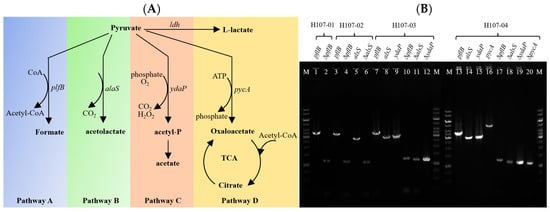
Figure 1
Open AccessReview
Changes in the Gut Microbiota of Patients After SARS-CoV-2 Infection: What Do We Know?
by
Isabel de Souza Andrade Arruda, Caio da Silva Cavalcante, Rebeca Siqueira Rubens, Larissa Nava Pinto de Faria Castro, Yanna Karla de Medeiros Nóbrega and Tanise Vendruscolo Dalmolin
Microorganisms 2025, 13(11), 2529; https://doi.org/10.3390/microorganisms13112529 - 4 Nov 2025
Abstract
COVID-19 can cause long-term symptoms, such as a post-infection syndrome, known as Long-COVID. Among the symptoms present during this period, the most reported are gastrointestinal symptoms. This study discusses the effects of changes in the gut microbiota of post-COVID-19 patients. SARS-CoV-2 infection is
[...] Read more.
COVID-19 can cause long-term symptoms, such as a post-infection syndrome, known as Long-COVID. Among the symptoms present during this period, the most reported are gastrointestinal symptoms. This study discusses the effects of changes in the gut microbiota of post-COVID-19 patients. SARS-CoV-2 infection is associated with significant alterations in gut microbial composition, disturbing its homeostasis and promoting a reduction in the abundance of beneficial symbiotic bacteria and an increase in the abundance of opportunistic pathogens. Furthermore, the composition of the gut microbiota may play a role in the prognosis of patients with post-COVID-19 infection. The microbiota of the intestinal tract and the respiratory tract influence each other; therefore, the gut–lung axis has attracted increasing interest in understanding COVID-19. Moreover, the brain–gut axis has been studied, since there have been reports of anxiety and depression along with post-COVID-19 gastrointestinal symptoms. Treatments options for intestinal dysbiosis in Long-COVID patients include probiotics, prebiotics, and fecal microbiota transplantation. These treatments may serve as an approach to improve gastrointestinal symptoms during Long-COVID, increasing microbiome diversity, strengthening the integrity of intestinal barrier functions, and consequently influencing the treatment of COVID-19.
Full article
(This article belongs to the Section Virology)
►▼
Show Figures
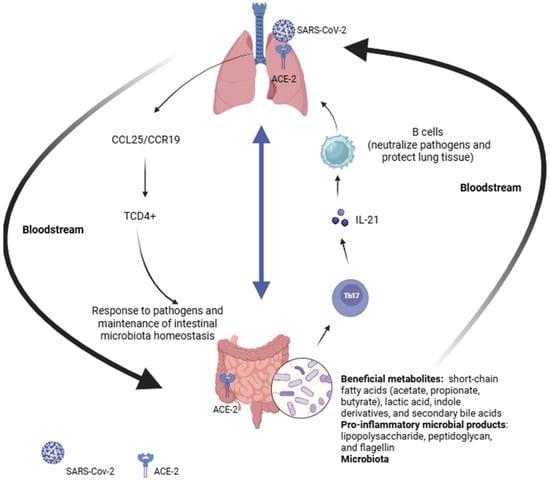
Figure 1
Open AccessArticle
Genome Mining Reveals Pathways for Terpene Production in Aerobic Endospore-Forming Bacteria Isolated from Brazilian Soils
by
Felipe de Araujo Mesquita, Waldeyr Mendes Cordeiro da Silva, Taina Raiol, Marcelo de Macedo Brigido, Nalvo Franco de Almeida, Bruna Fuga, Danilo de Andrande Cavalcante and Marlene Teixeira De-Souza
Microorganisms 2025, 13(11), 2528; https://doi.org/10.3390/microorganisms13112528 - 4 Nov 2025
Abstract
Terpenes are the largest category of specialised metabolites. Aerobic endospore-forming bacteria (AEFB), a diverse group of microorganisms, can thrive in various habitats and produce specialised metabolites, including terpenes. This study investigates the potential for terpene biosynthesis in 10 AEFB strain whole-genome sequences by
[...] Read more.
Terpenes are the largest category of specialised metabolites. Aerobic endospore-forming bacteria (AEFB), a diverse group of microorganisms, can thrive in various habitats and produce specialised metabolites, including terpenes. This study investigates the potential for terpene biosynthesis in 10 AEFB strain whole-genome sequences by performing a bioinformatics analyses to identify genes associated with these isoprene biosynthesis pathways. Specifically, we focused on the sequences coding for enzymes in the methylerythritol-phosphate (MEP) pathway and the polyprenyl synthase family, which play crucial roles in synthesising terpene precursors together with terpene synthases. A comparative analysis revealed the unique genetic architecture of these biosynthetic gene clusters (BGCs). Our results indicated that some strains possessed the complete genetic machinery required to produce terpenes such as squalene, hopanoids, and carotenoids. We also reconstructed phylogenetic trees based on the amino acid sequences of terpene synthases, which aligned with the phylogenetic relationships inferred from the whole-genome sequences, suggesting that the production of terpenes is an ancestor property in AEFB. Our findings highlight the importance of genome mining as a powerful tool for discovering new biological activities. Furthermore, this research lays the groundwork for future investigations to enhance our understanding of terpene biosynthesis in AEFB and the potential applications of these Brazilian environmental strains.
Full article
(This article belongs to the Section Environmental Microbiology)
►▼
Show Figures
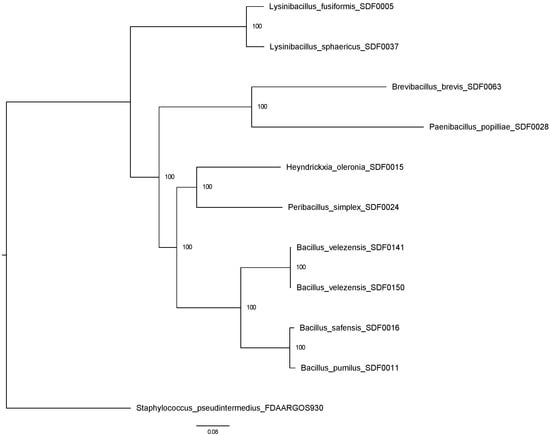
Figure 1
Open AccessArticle
Norditerpene Natural Products from Subterranean Fungi with Anti-Parasitic Activity
by
Alexandra Kolas, Yudi Rusman, Ana C. R. G. Maia, Jessica M. Williams, Jiashu Xie, Roshan Katekar, Fernanda G. Fumuso, Alexis Cotto-Rosario, Chidiebere N. Onoh, Hanen Baggar, Mary L. Piaskowski, Christian Baigorria, Raphaella Paes, Debopam Chakrabarti, Lyssa J. Weible, Kayode K. Ojo, Roberta M. O’Connor and Christine E. Salomon
Microorganisms 2025, 13(11), 2527; https://doi.org/10.3390/microorganisms13112527 - 4 Nov 2025
Abstract
Cryptosporidium is a waterborne gastrointestinal parasite that causes diarrheal disease worldwide. Currently, there are no effective therapeutics to treat cryptosporidiosis. Since natural products are a known source of anti-parasitic compounds, we screened a library of extracts and pure compounds isolated from bacteria and
[...] Read more.
Cryptosporidium is a waterborne gastrointestinal parasite that causes diarrheal disease worldwide. Currently, there are no effective therapeutics to treat cryptosporidiosis. Since natural products are a known source of anti-parasitic compounds, we screened a library of extracts and pure compounds isolated from bacteria and fungi collected from subterranean environments for anti-Cryptosporidium activity. Seven norditerpene lactones isolated from the fungus Oidiodendron truncatum collected from the Soudan Iron mine in Minnesota showed potent activity and were further tested to identify the most active compounds. The availability of a diverse suite of natural structural analogs with varying activities allowed us to determine some structure–activity relationships for both anti-parasitic activity and cytotoxicity. The two most potent compounds, oidiolactones A and B, had EC50s against C. parvum of 530 and 240 nM, respectively, without cytotoxicity to host cells. Both compounds also inhibited the related parasite Toxoplasma gondii. Oidiolactone A was active against asexual, but not sexual, stages of C. parvum, and killed parasites within 8 h of treatment. This compound reduced C. parvum infection by 70% in IFNγ−/− mice, with no signs of toxicity. The high potency, low cytotoxicity, and in vivo activity combined with high production and synthetic accessibility make these oidiolactones attractive scaffolds for the development of new anti-Cryptosporidium therapeutics.
Full article
(This article belongs to the Section Antimicrobial Agents and Resistance)
►▼
Show Figures

Graphical abstract
Open AccessArticle
Harnessing a Surface Water-Based Multifaceted Approach to Combat Zoonotic Viruses: A Rural Perspective from Bangladesh and China
by
Yizhe Wu, Yuqing Long, Xueling Yang, Xin Du, Xinyan Du, Nusrat Zahan, Zhiqiang Deng, Chen Du and Songzhe Fu
Microorganisms 2025, 13(11), 2526; https://doi.org/10.3390/microorganisms13112526 - 4 Nov 2025
Abstract
Rural tropical regions face escalating threats from zoonotic AIV and dengue virus but lack sewered infrastructure for conventional wastewater surveillance. We implemented surface water-based surveillance (SWBS) in peri-urban Dhaka (Bangladesh) and Ruili (China) from July to November 2023 and coupled it with machine
[...] Read more.
Rural tropical regions face escalating threats from zoonotic AIV and dengue virus but lack sewered infrastructure for conventional wastewater surveillance. We implemented surface water-based surveillance (SWBS) in peri-urban Dhaka (Bangladesh) and Ruili (China) from July to November 2023 and coupled it with machine learning-enhanced digital epidemiology. Reverse transcription quantitative PCR (RT-qPCR) was employed to detect the M gene of AIV and to subtype H1, H5, H7, H9, and H10 in surface water. Wild bird feces (n = 40) were collected within 3 km of positive sites to source-track AIV. For the dengue virus, a serogroup-specific RT-qPCR assay targeting the CprM gene was used. Genomic sequencing of AIV and dengue virus was performed to elucidate phylogenetic relationships with local clinical strains. Clinical data related to dengue fever were also collected for correlation analysis. Meanwhile, 13 dengue-related keyword search volumes were harvested daily from Google, Bing and Baidu for four cities to reveal the relationship between dengue epidemics and the web search index. AIV H5 was detected in Dhaka city from week 38, peaking at week 39, while dengue virus was persistently detected from week 29 to week 45, aligning with clinical trends. Time-series cross-correlation analysis revealed that variations in surface water viral load led clinical case reports by approximately two weeks (max CCF = 0.572 at lag −2). In Ruili city, dengue virus was detected from week 32 to week 44. To sharpen sensitivity, 383 weekly web search series for 13 dengue keywords from four countries were screened; random-forest and XGBoost models retained five symptom queries that generated a composite index explaining 79% of variance in dengue RNA levels in an independent Ruili test set (n = 24) and reduced superfluous sampling by 35%. Phylogenetic analysis verified identity between water-derived and patient-derived DENV-2, confirming local transmission. The study demonstrates that AIV SWBS is optimally integrated with wild bird sampling for source attribution, whereas dengue SWBS achieves maximal efficiency when combined with real-time web search monitoring, providing tailored, low-cost early-warning modules for resource-constrained tropical settings.
Full article
(This article belongs to the Special Issue One Health Research on Infectious Diseases)
►▼
Show Figures

Figure 1
Open AccessArticle
Investigating the Biological Characteristics and Pathogenic Potential of Listeria innocua Isolated from Food Through Comparative Genomics
by
Bo Zhang, Runlai Cao, Qilin Wang, Pan Hu, Yacong Li, Ziyu Liu, Zhuqing Xue, Weiyang Wang, Shasha Zhang and Xiaoxu Wang
Microorganisms 2025, 13(11), 2525; https://doi.org/10.3390/microorganisms13112525 - 2 Nov 2025
Abstract
L. monocytogenes is a common foodborne pathogen that typically causes infections through the consumption of food contaminated with this bacterium. This study seeks to elucidate the biodiversity as well as evolutionary characteristics of L. innocua strains from different regions using comparative genomics, exploring
[...] Read more.
L. monocytogenes is a common foodborne pathogen that typically causes infections through the consumption of food contaminated with this bacterium. This study seeks to elucidate the biodiversity as well as evolutionary characteristics of L. innocua strains from different regions using comparative genomics, exploring the virulence and pathogenic potential of these strains. The findings are expected to deepen our understanding of L. innocua and provide valuable reference for public health risk assessment related to this bacterium. We performed comparative genomics on 108 food-source L. innocua isolates sourced from the USA, England, China, and Egypt to explore their biological traits and assess their pathogenic potential by predicting virulence and antibiotic resistance genes, with subsequent validation of pathogenicity through animal studies. Pan-genomic analysis showed that geographically distinct L. innocua strains possess open genomes, offering a stable genetic basis that facilitates adaptation to diverse environments. Through virulence gene prediction, we found that L. innocua strains from different regions harbor virulence genes identical to those found in pathogenic L. monocytogenes, such as inlA and inlB, as well as internal genes that may enhance the pathogenic potential of the strains. This finding demonstrates that L. innocua strains exhibit pathogenic potential. To validate their virulence, we subsequently conducted virulence assays utilizing the Galleria mellonella larval model. Following infection with L. innocua, 100% mortality was observed in a subset of Galleria mellonella larvae, albeit with a delayed time to death compared to L. monocytogenes infection. This indicates that while L. innocua exhibits attenuated virulence relative to L. monocytogenes, it retains pathogenicity. Consequently, the potential contribution of L. innocua to listeriosis cannot be overlooked in public health risk assessments. L. innocua strains isolated from food can carry virulence and resistance genes identical to those found in pathogenic L. monocytogenes strains, indicating that these L. innocua strains possess certain virulence and pathogenic potential, which was further validated through subsequent animal experimentation. This study enhances our genomic understanding of L. innocua and underscores that detecting its key virulence genes is critical for public health safety, thereby providing valuable insights into its pathogenic potential.
Full article
(This article belongs to the Section Public Health Microbiology)
►▼
Show Figures

Figure 1
Open AccessArticle
Nanobodies Targeting the GP4 Protein Inhibit PRRSV Replication
by
Wenxiang Zhang, Aodi Wu, Honghuan Li, Tao He, Qianqian Dong, Hanwen Zhang, Jie Chen, Song Jiang and Jinliang Sheng
Microorganisms 2025, 13(11), 2524; https://doi.org/10.3390/microorganisms13112524 - 2 Nov 2025
Abstract
Porcine reproductive and respiratory syndrome virus (PRRSV) infection inflicts enormous economic losses on the global swine industry and imposes significant pressure on agricultural production. However, there are currently no clinically approved effective therapeutics specifically targeting PRRSV. Accordingly, the development of novel antiviral agents
[...] Read more.
Porcine reproductive and respiratory syndrome virus (PRRSV) infection inflicts enormous economic losses on the global swine industry and imposes significant pressure on agricultural production. However, there are currently no clinically approved effective therapeutics specifically targeting PRRSV. Accordingly, the development of novel antiviral agents against PRRSV is urgently needed. Notably, the structural glycoprotein 4 (GP4) of PRRSV—which plays a crucial role in viral entry into host cells—represents a promising target for antiviral development. Nanobodies, characterized by their small size, structural stability, high affinity, and excellent solubility, have emerged as attractive candidates for next-generation therapeutic development. Yet, to date, no specific nanobodies targeting PRRSV GP4 have been reported. In this study, we isolated GP4-specific nanobodies using phage display technology and investigated their mechanisms underlying viral suppression through a series of in vitro functional assays. Our results demonstrate that Nb6, Nb31, and Nb85 significantly inhibit PRRSV infection by disrupting both viral attachment to host cells and subsequent internalization processes. Collectively, these findings indicate that Nb6, Nb31, and Nb85 hold substantial potential for development as antiviral agents against PRRSV infection.
Full article
(This article belongs to the Section Veterinary Microbiology)
►▼
Show Figures

Graphical abstract
Open AccessArticle
Exploratory In Vitro Evaluation of Maternal–Infant Bifidobacterium Strains for Microbiota Modulation in a Pediatric Cystic Fibrosis Context
by
Maria Esteban-Torres, Isabel Blanco, Andrea Asensio-Grau, Nuria Ruiz, Manuel Bernabeu and Joaquim Calvo-Lerma
Microorganisms 2025, 13(11), 2523; https://doi.org/10.3390/microorganisms13112523 - 2 Nov 2025
Abstract
This study explores the potential of novel Bifidobacterium isolates as targeted probiotic supplements for children with cystic fibrosis (CF), a condition often associated with gut dysbiosis. Five strains of Bifidobacterium genus (B. animalis IATA01, B. pseudocatenulatum IATA35, B. longum
[...] Read more.
This study explores the potential of novel Bifidobacterium isolates as targeted probiotic supplements for children with cystic fibrosis (CF), a condition often associated with gut dysbiosis. Five strains of Bifidobacterium genus (B. animalis IATA01, B. pseudocatenulatum IATA35, B. longum IATA02, B. bifidum IATA13, and B. longum IATA05) isolated from maternal–infant fecal samples were assessed in vitro following the FAO/WHO guidelines. Their probiotic potential was evaluated through simulated gastrointestinal digestion in the CF context, their adhesion to mucin, and their carbohydrate fermentation capacity. Additionally, their impact on colonic microbiota modulation was analyzed using static in vitro colonic fermentation with fecal inocula from four pediatric patients with CF to assess the presence of different bacterial groups associated with dysbiosis via qPCR and short-chain fatty acid production by GC-MS. Three strains (IATA01, IATA35, and IATA05) demonstrated survival after gastrointestinal digestion, with IATA01 exhibiting the highest adhesion to mucin but limited carbohydrate fermentation capacity. All strains increased the Bifidobacterium levels after colonic fermentation, while their effects on reducing pathogenic groups and promoting beneficial bacteria such as Akkermansia and Faecalibacterium varied depending on the strain and the individual inoculum. These findings highlight the strain-specific effects of Bifidobacterium and evidence a specific impact on colonic microbiota, depending on the composition of the basal inoculum, highlighting individual-specific responses.
Full article
(This article belongs to the Section Gut Microbiota)
►▼
Show Figures
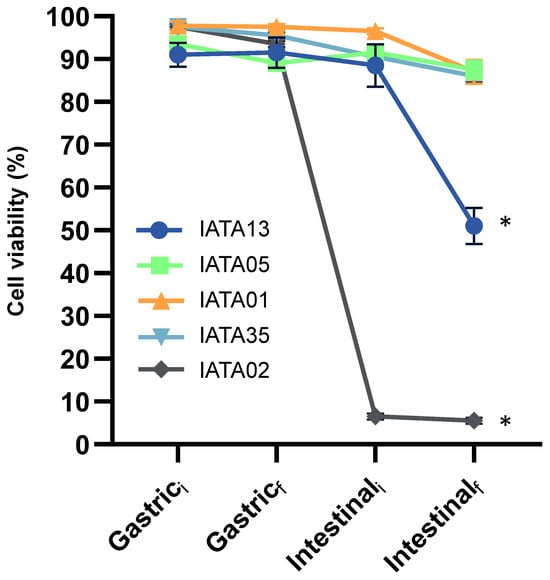
Figure 1
Open AccessArticle
Heavy Metal and Petroleum Hydrocarbon Contaminants Promote Resistance and Biofilm Formation in Vibrio Species from Shellfish
by
Gongshi Lin, Yingpeng Li, Ying Qiao, Theerakamol Pengsakul, Guobin Chen and Lixing Huang
Microorganisms 2025, 13(11), 2522; https://doi.org/10.3390/microorganisms13112522 - 2 Nov 2025
Abstract
Shellfish are an essential component of the human diet, yet their safety is increasingly compromised by contamination with heavy metals, petroleum hydrocarbons, and pathogenic microorganisms, such as Vibrio, which pose significant health risks. This study examined shellfish samples from seafood markets, assessing
[...] Read more.
Shellfish are an essential component of the human diet, yet their safety is increasingly compromised by contamination with heavy metals, petroleum hydrocarbons, and pathogenic microorganisms, such as Vibrio, which pose significant health risks. This study examined shellfish samples from seafood markets, assessing the levels of heavy metals (e.g., cadmium, copper) and petroleum hydrocarbons, while isolating and identifying Vibrio species carried by the shellfish. The antimicrobial resistance profiles, resistance genes, and biofilm-forming capacities of these strains were further characterized. Results revealed significant seasonal fluctuations in heavy metal concentrations, with some samples exceeding regulatory limits, indicating potential health risks for long-term consumers. Likewise, Vibrio abundance and resistance varied seasonally, with a notable prevalence of multidrug-resistant strains, likely influenced by antibiotic misuse and environmental pressures in coastal regions. Correlation analyses suggested potential links between heavy metal contamination and Vibrio resistance, as well as biofilm formation, supporting the hypothesis that metal-induced stress may facilitate resistance gene transfer and enhance biofilm-mediated resistance. This study reveals the seasonal dynamics of antimicrobial resistance (AMR) in shellfish-derived Vibrio species and elucidates the dose–response effects of heavy metals and petroleum hydrocarbons, as well as their synergistic selection mechanisms. These findings provide a scientific foundation for assessing shellfish safety, deciphering AMR transmission, and developing ecosystem-based strategies for aquaculture monitoring.
Full article
(This article belongs to the Section Biofilm)
►▼
Show Figures

Figure 1
Open AccessReview
Probiotic Potential of Traditional and Emerging Microbial Strains in Functional Foods: From Characterization to Applications and Health Benefits
by
Chijioke Christopher Uhegwu and Christian Kosisochukwu Anumudu
Microorganisms 2025, 13(11), 2521; https://doi.org/10.3390/microorganisms13112521 - 2 Nov 2025
Abstract
Global consumer demand for probiotic-enriched functional foods has increased as consumers become increasingly aware of the connection between what they eat and its role in their long-term health. Compared with conventional foods that primarily deliver fundamental nutrients, functional foods include biologically active compounds
[...] Read more.
Global consumer demand for probiotic-enriched functional foods has increased as consumers become increasingly aware of the connection between what they eat and its role in their long-term health. Compared with conventional foods that primarily deliver fundamental nutrients, functional foods include biologically active compounds capable of influencing physiological processes. While traditionally used probiotic strains like Lactobacillus and Bifidobacterium are still at the center of this trend, there is growing interest in the exploration of emerging and novel microbial candidates that harbor new functional properties. This review addresses the characterization, modes of action, technological limitations, regulatory guidelines, and prospective health benefits of new probiotic strains in functional foods. The review further highlights the need for precise strain selection, novel encapsulation technologies for viability, and strict safety assessments in accordance with EFSA’s QPS (Qualified Presumption of Safety) and the United States FDA GRAS (Generally Recognized As Safe) specifications. Current research focuses on the classical benefits of probiotics, including gut microbiota modulation, immunomodulation, antimicrobial activity, lowering of cholesterol, and mental health. However, long-term clinical validation, strain specificity, personalized application, and effective communication to consumers are some areas where gaps remain. Addressing these challenges through the incorporation of omics technologies, synthetic biology, and more detailed microbiome–host interaction studies will be the key to unlocking the full potential of next-generation probiotics and sustaining consumer trust in this emerging market.
Full article
(This article belongs to the Special Issue Microbial Safety and Beneficial Microorganisms in Foods)
►▼
Show Figures

Figure 1
Open AccessArticle
Effect of High-Temperature Stress on Fatty Acid Composition and Undecylprodiginine Biosynthesis in Streptomyces coelicolor M511
by
Youngjong Han, Yujun Park, Kyudong Han and SangJoon Mo
Microorganisms 2025, 13(11), 2520; https://doi.org/10.3390/microorganisms13112520 - 1 Nov 2025
Abstract
Actinomycetes are a representative group of bacteria that inhabit soil; in particular, Streptomyces coelicolor M511 produces actinorhodin and undecylprodiginine. Among them, undecylprodiginine has antibiotic and immunosuppression activity and is a secondary metabolite with high potential applications in biotechnological and pharmaceutical fields. High temperature
[...] Read more.
Actinomycetes are a representative group of bacteria that inhabit soil; in particular, Streptomyces coelicolor M511 produces actinorhodin and undecylprodiginine. Among them, undecylprodiginine has antibiotic and immunosuppression activity and is a secondary metabolite with high potential applications in biotechnological and pharmaceutical fields. High temperature stress (37 °C) reduced the biosynthesis of undecylprodiginine and induced specific branched chain alkylprodiginine derivatives, compared with the optimal growth temperature (30 °C). Also, the stress stimulated the synthesis of straight-chain FA for enhancing membrane rigidity. The inhibition of undecylprodiginine biosynthesis under high temperature stress seems to be induced by the heat sensitivity of the RedP enzyme, and this inhibition is compensated by FAS FabH. Since FabH, a homologue of RedP, has a broader substrate specificity, it leads to the production of methylundecylprodiginine and methyldodecylprodiginine. The external addition of isoleucine (as well as that of leucine and valine to a far lesser extent) enhances the synthesis of these derivatives since isoleucine catabolism generates precursors used for the biosynthesis of these compounds. These findings reveal temperature-dependent changes in precursor utilization and prodiginine diversity, providing insights into metabolic plasticity and strategies establishing a foundation for secondary metabolite derivatives engineering strategies through precursor supplementation or temperature regulation.
Full article
(This article belongs to the Section Microbial Biotechnology)
►▼
Show Figures

Figure 1
Open AccessArticle
Characterization of Bacterial Communities in Volcanic Soil from Northern Patagonian Area of Chile
by
Patricia Aguila-Torres, Mauricio González, Marcela Hernández, Constanza Aguado-Norese, Jonathan E. Maldonado, Richard M. Miranda, Roxana González-Stegmaier, Daniel E. Palma, Luis A. Rojas and Macarena Mellado
Microorganisms 2025, 13(11), 2519; https://doi.org/10.3390/microorganisms13112519 - 1 Nov 2025
Abstract
Osorno volcano (41.1° S, 72° W) is located in the Andean Southern Volcanic Zone. The volcano lies within a national park as part of the protected areas system. This setting provides an opportunity to compare soil microbial communities between sectors with (H) and
[...] Read more.
Osorno volcano (41.1° S, 72° W) is located in the Andean Southern Volcanic Zone. The volcano lies within a national park as part of the protected areas system. This setting provides an opportunity to compare soil microbial communities between sectors with (H) and without (NI) anthropogenic activities within a volcanic territory. To do so, we selected one of the most visited volcanoes in Chilean Patagonia to examine composition, diversity (taxonomic and phylogenetic), and co-presence and mutual exclusion interaction networks between members of volcanic soil bacterial communities. Soil DNA was extracted, and the 16S rRNA gene was analyzed by high-throughput DNA sequencing, followed by taxonomic identification. The most prevalent phylum across all sites (H and NI) was Pseudomonadota, followed by Acidobacteriota, Actinobacteriota, and Chloroflexota. Based on taxonomic and phylogenetic indices, we found that the diversity of bacteria was significantly less in the humanized area than in the non-intervened areas. Beta diversity analysis also revealed a clear separation between humanized and non-intervened soils. Additionally, a decrease in network connectivity was observed at NI sites. Our results provide clear evidence that anthropogenic factors, such as tourism, vehicle parking, and combustion processes, are key drivers shaping bacterial community structure in volcanic soils, with potential consequences for ecosystem health and the capacity to provide ecosystem services.
Full article
(This article belongs to the Special Issue Earth Systems: Shaped by Microbial Life)
►▼
Show Figures

Figure 1
Open AccessArticle
β-Actin as an Endogenous Control Gene in Real-Time PCR for Detection of West Nile and Usutu Virus in Mosquitoes
by
Jeanne Lai, Carlotta Tessarolo, Elisabetta Ercole, Marina Gallo, Monica Lo Faro, Claudia Palmitessa, Valerio Carta, Alessio Ferrari, Alessandra Favole, Mattia Begovoeva, Francesco Ingravalle, Simone Peletto, Nicolò Francesco Fiscella, Roberta Irelli, Eugenia Ciarrocchi, Walter Martelli, Andrea Mosca, Giulia Cagnotti, Cristina Casalone and Cristiano Corona
Microorganisms 2025, 13(11), 2518; https://doi.org/10.3390/microorganisms13112518 - 31 Oct 2025
Abstract
Mosquito-borne viruses like West Nile virus (WNV) and Usutu virus (USUV) present growing public health concerns, especially with climate change and expanding vector ranges. This study describes the development and validation of a duplex Real-Time RT-PCR assay targeting β-actin (ACTB) mRNA as an
[...] Read more.
Mosquito-borne viruses like West Nile virus (WNV) and Usutu virus (USUV) present growing public health concerns, especially with climate change and expanding vector ranges. This study describes the development and validation of a duplex Real-Time RT-PCR assay targeting β-actin (ACTB) mRNA as an endogenous control and a conserved 92 bp region shared by WNV and USUV genomes. Degenerate primers for ACTB ensure RNA extraction quality and PCR performance while enabling simultaneous detection of both viruses. A total of 1002 mosquito pools collected in Piedmont, Italy, during the 2024 vector season under the National Surveillance Plan for Arboviruses (PNA), were tested. The assay showed 100% accuracy—ACTB mRNA was detected in all pools, and six pools tested positive for WNV or USUV (three each). Diagnostic specificity was confirmed on 40 horse and bovine serum samples. Sanger sequencing confirmed ACTB identity across multiple mosquito species. The assay also demonstrated reproducibility across different operators and thermocyclers. The limit of detection (LOD) evaluation showed that the assay is capable of detecting viral RNA at very low concentrations, confirming its high analytical sensitivity. The duplex RT-PCR here developed is a reliable, sensitive, and specific tool for arbovirus surveillance, combining pathogen detection with internal quality control of RNA extraction and amplification, thus improving early warning and rapid response to mosquito-borne disease threats.
Full article
(This article belongs to the Special Issue Interactions between Parasites/Pathogens and Vectors)
►▼
Show Figures

Figure 1
Open AccessArticle
Tackling Conifer Needle Cast and Ash Dieback with Host-Derived Microbial Antagonists Exhibiting Plant Growth-Promoting Traits
by
Milana Šilanskienė, Dorotėja Vaitiekūnaitė and Vaida Sirgedaitė-Polikaitienė
Microorganisms 2025, 13(11), 2517; https://doi.org/10.3390/microorganisms13112517 - 31 Oct 2025
Abstract
Needle cast (Lophodermium seditiosum Minter, Staley & Millar) in Scots pine (Pinus sylvestris L.) and European ash (Fraxinus excelsior L.) dieback (Hymenoscyphus fraxineus (T. Kowalski) Baral, Queloz & Hosoya) are among the most destructive forest and tree plantation diseases
[...] Read more.
Needle cast (Lophodermium seditiosum Minter, Staley & Millar) in Scots pine (Pinus sylvestris L.) and European ash (Fraxinus excelsior L.) dieback (Hymenoscyphus fraxineus (T. Kowalski) Baral, Queloz & Hosoya) are among the most destructive forest and tree plantation diseases in Europe, threatening not only targeted plant species but also the whole ecosystem. While considerable research effort has focused on microbial antagonists against ash dieback, comparable investigations into needle cast biocontrol remain virtually absent from the literature. Here, isolated microbial antagonists from European ash and Scots pine were evaluated for their efficacy against respective pathogens. In vitro dual-culture assays revealed bacteria with strong inhibitory effects on pathogen growth, as well as multiple plant growth-promoting traits (PGPTs). It was found that bacteria from the genera of Pantoea, Erwinia, Priestia, and Pseudomonas inhibited the growth of H. fraxineus by ≥70%. Most significantly, our investigation revealed that bacteria isolated from Scots pine, belonging to the genera Pseudomonas, Bacillus, and Priestia, inhibited the growth of L. seditiosum by 50% to 80%, representing one of the first reported bacterial antagonisms for this neglected pathogen. All isolates were positive for at least two PGPTs, primarily due to mineralization of organic phosphate and the production of siderophores. The dual functional traits of isolated bacteria highlight their potential application in integrated forest protection strategies, particularly for the previously overlooked L. seditiosum pathosystem.
Full article
(This article belongs to the Special Issue Plant Growth-Promoting Bacteria)
►▼
Show Figures

Graphical abstract
Open AccessReview
Gut Microbiome and Immune System Crosstalk in Chronic Inflammatory Diseases: A Narrative Review of Mechanisms and Therapeutic Opportunities
by
Jefferson J. Feng, Nikhil R. Maddirala, Ashley Saint Fleur, Fenfen Zhou, Di Yu, Feng Wei and Yongrong Zhang
Microorganisms 2025, 13(11), 2516; https://doi.org/10.3390/microorganisms13112516 - 31 Oct 2025
Abstract
The gut microbiota, a complex community of trillions of microorganisms residing in the gastrointestinal tract, plays a vital role in maintaining host health and regulating a wide range of physiological functions. Advances in molecular biology have greatly expanded our understanding of the dynamic
[...] Read more.
The gut microbiota, a complex community of trillions of microorganisms residing in the gastrointestinal tract, plays a vital role in maintaining host health and regulating a wide range of physiological functions. Advances in molecular biology have greatly expanded our understanding of the dynamic interactions between the gut microbiome and the immune system. Disruption of this microbial community, known as dysbiosis, can compromise epithelial barrier integrity, trigger aberrant immune activation, and lead to the production of proinflammatory metabolites. These changes are increasingly recognized as contributing factors in the pathogenesis of chronic inflammatory diseases. Emerging research highlights the gut microbiota as a key modulator of immune homeostasis, influencing both local and systemic inflammatory processes during the initiation and progression of these diseases. Understanding the mechanisms underlying gut microbiota-immune interactions will offer new avenues for therapeutic interventions. This review focuses on six representative chronic inflammatory diseases, including rheumatoid arthritis, inflammatory bowel disease, psoriasis, systemic lupus erythematosus, asthma, and vasculitis, all of which are characterized by dysregulated immune responses and persistent inflammation. Our goal is to synthesize the recent research on the role of gut microbiome in the pathogenesis of the diseases listed above and provide insights into the development of microbiota-based therapies, particularly fecal microbiota transplant, dietary modifications, prebiotic and probiotic interventions, for their treatment.
Full article
(This article belongs to the Special Issue Correlations Between the Gastrointestinal Microbiome and Diseases)
►▼
Show Figures

Graphical abstract
Open AccessReview
The Gut Microbiota of Drosophila melanogaster: A Model for Host–Microbe Interactions in Metabolism, Immunity, Behavior, and Disease
by
Kyu Hong Cho and Song Ok Kang
Microorganisms 2025, 13(11), 2515; https://doi.org/10.3390/microorganisms13112515 - 31 Oct 2025
Abstract
The gut microbiota of Drosophila melanogaster offers a simplified yet powerful system to study conserved mechanisms of host–microbe interactions. Unlike the highly complex mammalian gut microbiota, which includes hundreds of species, the fly gut harbors a small and defined community dominated by Lactobacillus
[...] Read more.
The gut microbiota of Drosophila melanogaster offers a simplified yet powerful system to study conserved mechanisms of host–microbe interactions. Unlike the highly complex mammalian gut microbiota, which includes hundreds of species, the fly gut harbors a small and defined community dominated by Lactobacillus and Acetobacter. Despite its low diversity, this microbiota exerts profound effects on host physiology. Commensal bacteria modulate nutrient acquisition, regulate insulin/TOR signaling, and buffer dietary imbalances to support metabolic homeostasis and growth. They also influence neural and behavioral traits, including feeding preferences, mating, and aggression, through microbial metabolites and interactions with host signaling pathways. At the immune level, microbial molecules such as peptidoglycan, acetate, uracil, and cyclic dinucleotides activate conserved pathways including Imd, Toll, DUOX, and STING, balancing antimicrobial defense with tolerance to commensals. Dysbiosis disrupts this equilibrium, accelerating aging, impairing tissue repair, and contributing to tumorigenesis. Research in Drosophila demonstrates how a low-diversity microbiota can shape systemic host biology, offering mechanistic insights relevant to human health and disease.
Full article
(This article belongs to the Special Issue Gut Microbiome in Homeostasis and Disease, 3rd Edition)
►▼
Show Figures

Figure 1
Open AccessCommunication
Recent Trends in Prevalence of HPV Infection in Nasopharyngeal Carcinoma in Japan
by
Luyao Liu, Nobuyuki Hirai, Satoru Kondo, Makiko Moriyama-Kita, Ryotaro Nakazawa, Shigetaka Komura, Makoto Kano, Daisuke Uno, Manabu Inaba, Takayoshi Ueno, Yosuke Nakanishi, Kazuhira Endo, Hisashi Sugimoto and Tomokazu Yoshizaki
Microorganisms 2025, 13(11), 2514; https://doi.org/10.3390/microorganisms13112514 - 31 Oct 2025
Abstract
Background: Nasopharyngeal carcinoma (NPC) is a malignant tumor in which the etiologic contribution of Epstein–Barr virus (EBV) is well established. However, similar to that of oropharyngeal carcinoma, some papers reported that human papilloma virus (HPV) contributed to the development of NPC in non-endemic
[...] Read more.
Background: Nasopharyngeal carcinoma (NPC) is a malignant tumor in which the etiologic contribution of Epstein–Barr virus (EBV) is well established. However, similar to that of oropharyngeal carcinoma, some papers reported that human papilloma virus (HPV) contributed to the development of NPC in non-endemic regions. Previously, we conducted a study on HPV infection in patients with NPC between 1996 and 2015 in our department. The current study aims to evaluate the incidence and role of HPV infection in NPC pathogenesis using samples of NPC after 2015. Methods: Paraffin-embedded tumor samples from 26 patients with NPC who were treated at our department between 2015 and 2022 were analyzed. HPV polymerase chain reaction, p16 immunohistochemistry, HPV genotyping, and in situ hybridization for EBV-encoded RNA were performed to determine the viral infection status. Results: Of the 26 patients, 19 (73%) were EBV-positive and HPV-negative, 1 (4%) was EBV-negative and HPV-positive, and 6 (23%) were negative for both EBV and HPV. The detection rate of HPV has slightly increased from 3% to 4% over the past decade. Conclusion: Although Japan is a non-endemic region for NPC, HPV infection is exceedingly rare and may have a limited role in NPC development in Japan. However, the detection rate of HPV has not significantly changed in the past decade, further supporting the view that HPV has a relatively small impact on the pathogenesis of NPC in Japan.
Full article
(This article belongs to the Section Virology)
Open AccessArticle
Metagenome-Based Functional Differentiation of Gut Microbiota and Ecological Adaptation Among Geographically Distinct Populations of Przewalski’s Gazelle (Procapra przewalskii)
by
Jingjie Zhang, Feng Jiang, Xiaohuan Li, Pengfei Song and Tongzuo Zhang
Microorganisms 2025, 13(11), 2513; https://doi.org/10.3390/microorganisms13112513 - 31 Oct 2025
Abstract
Przewalski’s gazelle (Procapra przewalskii) is an endangered ungulate endemic to the Qinghai–Tibet Plateau, with a small population size and exposure to multiple ecological pressures. Its gut microbiota may play a crucial role in host environmental adaptation. To investigate the functional divergence
[...] Read more.
Przewalski’s gazelle (Procapra przewalskii) is an endangered ungulate endemic to the Qinghai–Tibet Plateau, with a small population size and exposure to multiple ecological pressures. Its gut microbiota may play a crucial role in host environmental adaptation. To investigate the functional divergence of gut microbial communities, we performed high-throughput metagenomic sequencing on 105 wild fecal samples collected from 10 geographic regions around Qinghai Lake. The results revealed significant regional differentiation in key functional modules related to metabolism, antibiotic resistance mechanisms, and virulence-associated pathways. All populations showed enrichment in core metabolic pathways such as carbohydrate and amino acid metabolism, with carbohydrate-active enzymes dominated by glycoside hydrolases (GHs) and glycosyltransferases (GTs), exhibiting overall functional conservation. Although populations shared many antibiotic- and virulence-related reference genetic markers, the marker composition associated with distinct resistance mechanisms and pathogenic processes exhibited clear population-specific patterns, suggesting differential microbial responses to local environmental pressures. Correlation network analysis further identified core taxa (e.g., Arthrobacter and Oscillospiraceae/Bacteroidales lineages) as key genera linking community structure with core metabolic, resistance-related, and virulence-associated marker functions. Overall, the gut microbiota of Przewalski’s gazelle exhibits a complex spatially structured functional differentiation, reflecting host–microbiome co-adaptation under region-specific ecological pressures. These findings provide critical methodological and theoretical support for microecological health assessment and regionally informed conservation management of this endangered species.
Full article
(This article belongs to the Section Gut Microbiota)
►▼
Show Figures
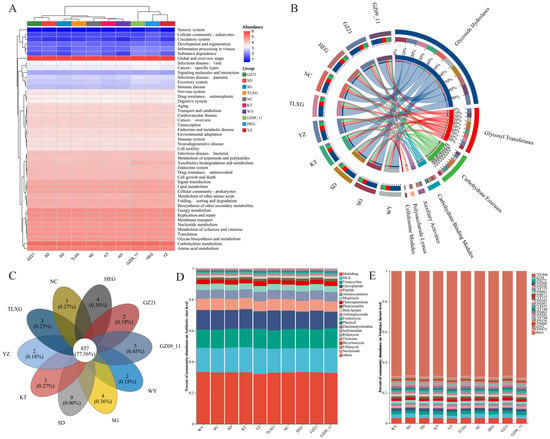
Figure 1
Open AccessArticle
Genetic Diversity and Clonal Expansion of Pathogenic Leptospira in Brazil: A Multi-Host and Multi-Regional Panorama
by
Maria Isabel Nogueira Di Azevedo and Walter Lilenbaum
Microorganisms 2025, 13(11), 2512; https://doi.org/10.3390/microorganisms13112512 - 31 Oct 2025
Abstract
Leptospirosis is a globally distributed zoonosis of major public health and veterinary relevance, caused by pathogenic species of the genus Leptospira. Brazil is a hotspot for transmission due to its ecological diversity and complex host–environment interfaces. This study explored the genetic diversity
[...] Read more.
Leptospirosis is a globally distributed zoonosis of major public health and veterinary relevance, caused by pathogenic species of the genus Leptospira. Brazil is a hotspot for transmission due to its ecological diversity and complex host–environment interfaces. This study explored the genetic diversity and structure of circulating pathogenic Leptospira spp. in Brazil through a single-locus sequence typing (SLST) analysis based on the secY gene. A total of 531 sequences were retrieved from GenBank and subjected to phylogenetic and haplotype diversity analyses. Maximum likelihood reconstruction revealed strongly supported clades for seven species, with L. interrogans being the most prevalent and broadly distributed across hosts and regions. This species showed evidence of clonal expansion, with a dominant haplotype (n = 242) shared by humans, domestic animals, and wildlife. In contrast, L. santarosai and L. noguchii exhibited high haplotypic diversity and reticulated network structures, reflecting greater evolutionary variability. The species L. kirschneri and L. borgpetersenii displayed reduced haplotypic variation, the latter mainly associated with cattle, consistent with its host-adapted profile. Host- and biome-based haplotype networks revealed both the broad ecological adaptability of certain lineages and the exclusive presence of haplotypes restricted to specific environments, such as those found in marine mammals from the Atlantic Ocean. Genetic distance analyses confirmed the strong taxonomic resolution of the gene secY, which effectively distinguished closely related species while capturing intraspecific diversity. These findings provide a comprehensive molecular overview of pathogenic Leptospira in Brazil, highlighting ecological connectivity across hosts and biomes, as well as the contrasting evolutionary dynamics among species. Beyond describing genetic patterns, our analyses emphasize evolutionary processes, host–environment connectivity, and the implications for One Health. This integrative framework strengthens the basis for surveillance and control strategies in other endemic regions in the world.
Full article
(This article belongs to the Special Issue Microparasites: Diversity, Phylogeny and Molecular Characterization)
►▼
Show Figures

Figure 1

Journal Menu
► ▼ Journal Menu-
- Microorganisms Home
- Aims & Scope
- Editorial Board
- Reviewer Board
- Topical Advisory Panel
- Instructions for Authors
- Special Issues
- Topics
- Sections & Collections
- Article Processing Charge
- Indexing & Archiving
- Editor’s Choice Articles
- Most Cited & Viewed
- Journal Statistics
- Journal History
- Journal Awards
- Society Collaborations
- Editorial Office
Journal Browser
► ▼ Journal BrowserHighly Accessed Articles
Latest Books
E-Mail Alert
News
Topics
Topic in
Biomass, Microorganisms, Sustainability, Water, Fermentation, Energies, Materials, Applied Biosciences
Recovery and Use of Bioactive Materials and Biomass
Topic Editors: Xiang Li, Tianfeng Wang, Xianbao XuDeadline: 25 November 2025
Topic in
Applied Microbiology, Bioengineering, Biology, Environments, Microorganisms
Environmental Bioengineering and Geomicrobiology
Topic Editors: Xian-Chun Zeng, Deng LiuDeadline: 20 December 2025
Topic in
Applied Microbiology, Fermentation, Foods, Microbiology Research, Microorganisms
Fermented Food: Health and Benefit
Topic Editors: Niel Van Wyk, Alice VilelaDeadline: 31 December 2025
Topic in
Applied Microbiology, Microbiology Research, Microorganisms, IJMS, IJPB, Plants
New Challenges on Plant–Microbe Interactions
Topic Editors: Wenfeng Chen, Junjie ZhangDeadline: 31 January 2026

Special Issues
Special Issue in
Microorganisms
Microbiome in Fish and Their Living Environment
Guest Editors: Yongjun Chen, Gang YangDeadline: 10 November 2025
Special Issue in
Microorganisms
Rhizosphere Microbial Community, 4th Edition
Guest Editor: Taegun SeoDeadline: 15 November 2025
Special Issue in
Microorganisms
Lactic Acid Bacteria in Food Fermentation and Biotechnology
Guest Editor: Spiros ParamithiotisDeadline: 15 November 2025
Special Issue in
Microorganisms
Microorganisms in Functional Foods: 2nd Edition
Guest Editor: Jadranka FreceDeadline: 15 November 2025
Topical Collections
Topical Collection in
Microorganisms
Device-Related Infections and Bacterial Biofilms
Collection Editor: María Guembe
Topical Collection in
Microorganisms
Feature Papers in Plant Microbe Interactions
Collection Editor: Rainer Borriss
Topical Collection in
Microorganisms
Feature Papers in Antimicrobial Agents and Resistance
Collection Editor: Maurizio Ciani
Topical Collection in
Microorganisms
Advances in SARS-CoV-2 Infection
Collection Editor: Carlo Contini



